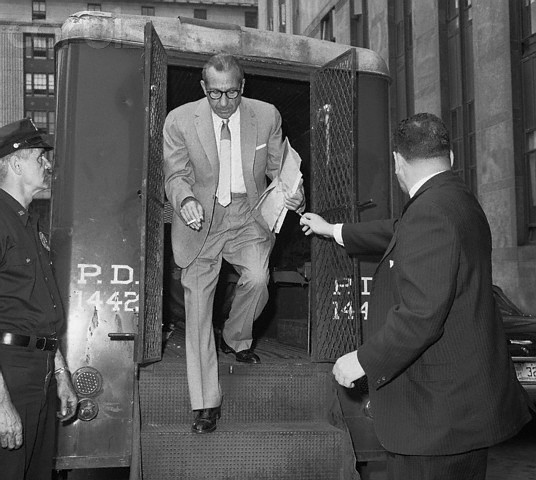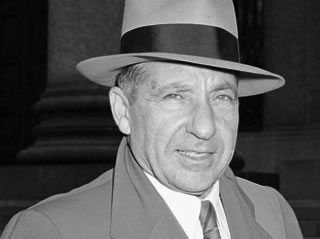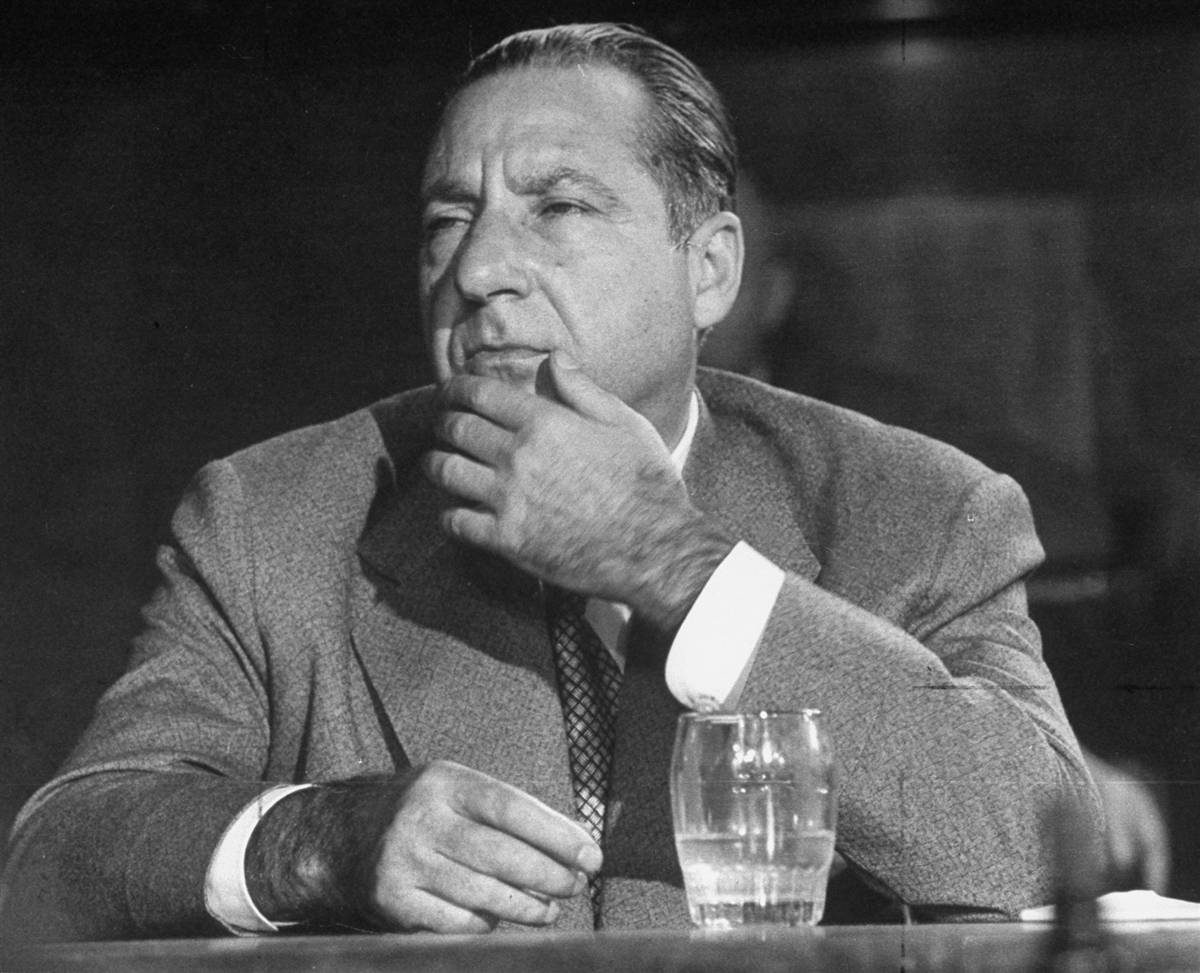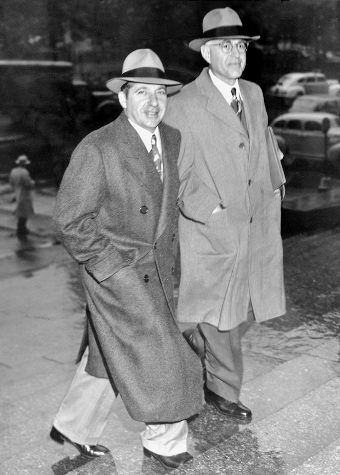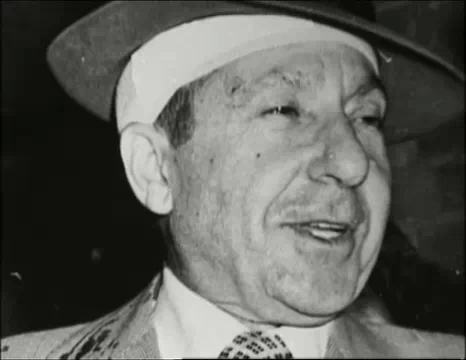<Back to Index>
- Boss of the Genovese Family Frank Costello (Francesco Castiglia), 1891
PAGE SPONSOR
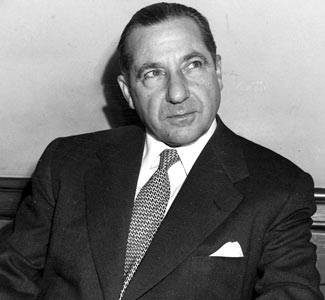
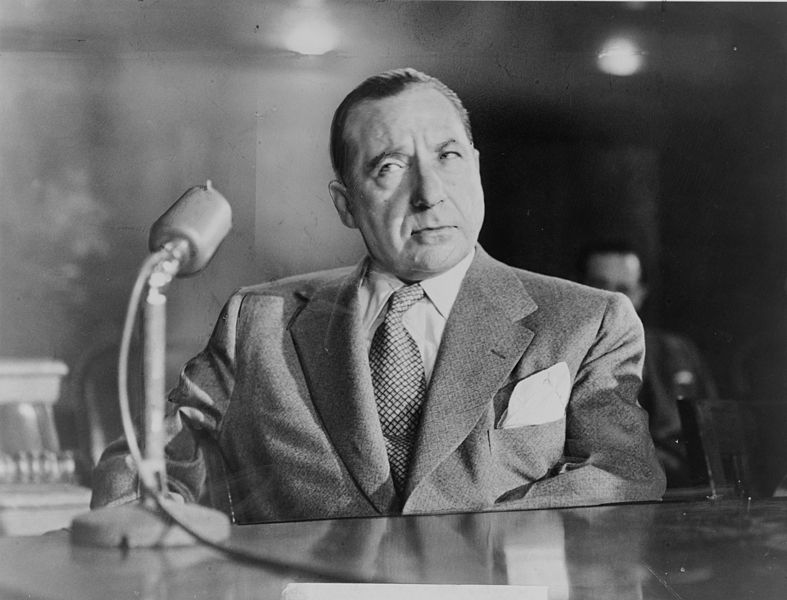
Frank Costello (born Francesco Castiglia; January 26, 1891 – February 18, 1973) was an Italian New York City gangster who rose to the top of America's underworld, controlled a vast gambling empire across the United States and enjoyed political influence.
Nicknamed the "Prime Minister of the Underworld", he became one of the most powerful and influential Mafia bosses in American history, eventually leading the Luciano crime family (later called the Genovese crime family).
Costello was born in Lauropoli, a mountain village in Calabria, Italy, in 1891. In 1900, he boarded a ship to the United States with his mother and his brother Edward in order to join their father, who had moved to New York's East Harlem several
years earlier and opened a small neighborhood Italian grocery store.
While Costello was still a boy, his brother introduced him to gang
activities. By age 13, Costello had become a member of a local gang and
started using the name Frankie. Costello continued to commit petty crimes, and went to jail for assault and robbery in 1908, 1912 and 1917. In 1918, Costello married Lauretta Giegerman, a Jewish girl
who was the sister of a close friend. That same year, Costello served
ten months in jail for carrying a concealed weapon. After his release,
Costello decided to avoid street rackets and use his brain to make money
as a criminal. Foregoing the use of violence as a road to success and
wealth, Costello claimed that he never again carried a gun. Costello
would not return to jail for 37 years.
While working for the Morello gang, Costello met Charlie "Lucky" Luciano, the Sicilian leader of Manhattan's Lower East Side gang. The two Italians immediately became friends and partners. Several older members of Luciano's family disapproved of this growing partnership; they were mostly old - school mafiosi who were unwilling to work with anyone who was not Sicilian, let alone anyone not Italian. To Luciano's shock, they warned him against working with Costello, whom they called "the dirty Calabrian." Along with Italian - American associates Vito Genovese and Tommy "Three - Finger Brown" Lucchese and Jewish associates Meyer Lansky and Benjamin "Bugsy" Siegel, the gang became involved in robbery, theft, extortion, gambling and narcotics. The Luciano - Costello - Lansky - Siegel alliance prospered even further with the passage of Prohibition in 1920. The gang went into bootlegging, backed by criminal financier Arnold Rothstein.
The success of the young Italians let them make business deals with the leading Jewish and Irish criminals of the era, including Dutch Schultz, Owney "The Killer" Madden and William "Big Bill" Dwyer. Rothstein became a mentor to Costello, Luciano, Lansky and Siegel while they conducted bootlegging business with Bronx beer baron Schultz. In 1922, Costello, Luciano, and their closest Italian associates joined the Sicilian Mafia crime family led by Joe "the Boss" Masseria, a top Italian underworld boss. By 1924, Costello had become a close associate of Hell's Kitchen's Irish crime bosses Dwyer and Madden. Costello became deeply involved in their rum running operations, known as "The Combine"; this could have prompted his name change.
In 1926, Combine boss Bill Dwyer was convicted of bribing a United States Coast Guard official and sentenced to two years in jail. After Dwyer was imprisoned, Costello took over the Combine's operations with Owney Madden. This caused friction between Madden and top Dwyer lieutenant, Charles "Vannie" Higgins. Higgins, referred to as Brooklyn's "Last Irish Crime Boss," believed he should be running the Combine, not Costello. Thus, the "Manhattan Beer Wars" began between Higgins on one side, and Costello, Madden, and Schultz on the other. At this particular time, Schultz was also having problems with gangsters Jack "Legs" Diamond and Vincent "Mad Dog" Coll. With Higgins' help, these two hoodlums had begun to rival Schultz and his partners. Eventually, the Costello - Madden - Schultz alliance was destroyed by New York's underworld.
Costello continued to be a very influential gangster throughout the 1920s. Costello kept close associates Luciano, Lansky and Siegel involved in most of his gambling rackets, which included punch cards, slot machines, bookmaking and floating casinos. Costello eventually became known as the "Prime Minister of the Underworld" for his cultivation of associations and business relationships with New York's criminals, politicians, businessmen, judges, and police officials. As he followed the "Big Three" ideology of mixing crime, business and politics, Costello's underworld influence grew. His fellow gangsters considered Frank to be an important link between the Mafia and the politicians of Tammany Hall, New York's Democratic Party organization. This relationship gave Costello and his associates, including Luciano, the opportunity to buy the favors of politicians, judges, district attorneys, cops, city officials and anyone else they needed to bribe in order to freely run their criminal operations.
In 1927, Costello, Luciano, and former Chicago gangster John "Johnny the Fox" Torrio organized
a group of top East Coast rum runners into a large bootlegging
operation. This gang was able to pool their Canadian and European liquor
sources, maximize profits, minimize overhead, and gain an advantage
over their competition. The operation was known as the "Big Seven
Group", the first concrete move in organizing the American underworld
into a national crime syndicate. In May 1929, Costello, Luciano, Torrio,
Lansky, and Atlantic City / South Jersey crime boss, Enoch "Nucky" Johnson hosted a crime convention in Atlantic City, New Jersey.
This convention included the members of the "Big Seven Group" and the
top crime leaders from across the nation. This was the first true
underworld meeting and the biggest step in forming a National Crime Syndicate that
would control criminal operations, dictate policy, enforce rules, and
maintain authority in the national underworld. Masseria and Salvatore Maranzano were not invited because their Old World ideas ran counter to the convention's goals.
By 1928, Costello and Luciano were considered to be two young, ambitious, and powerful gangsters on the rise. However, an internal conflict in the Italian underworld would sidetrack Costello and associates. Masseria was facing a challenge from Maranzano, a recent arrival from Palermo, Sicily, who was born in Castellammare del Golfo, Sicily. When Maranzano arrived in New York in 1925, his access to money and manpower let him quickly set up rum running, bootlegging, extortion and gambling operations that directly competed with Masseria, Costello's boss. On October 10, 1928, Joe Masseria eliminated his top rival for the coveted "boss of bosses" title, Brooklyn boss, Salvatore "Tata" D'Aquila. However, Masseria still had to deal with the powerful and influential Maranzano and his Castellammarese Clan.
Joe Masseria became an underworld dictator, requiring absolute loyalty and obedience from the other four New York families. In 1930, Masseria demanded a $10,000 tribute from the leader of Maranzano's crime family and got it. The Castellammarese Clan leader, Nicola "Cola" Schiro fled New York in fear, leaving Maranzano as the new leader. By 1931, a series of killings in Detroit, Chicago and New York involving Castellammarese clan members and associates caused Maranzano and his family to declare war against Joe Masseria and his allies. These allies included Costello and his associates, Luciano, Vito Genovese and Joe Adonis. Another Masseria ally was the large Mineo crime family (formerly D'Aquila), whose members included Costello associates Albert "The Mad Hatter" Anastasia, Carlo Gambino, and Frank Scalice. The Castellammarese clan included Joseph "Joe Bananas" Bonanno and Stefano Magaddino, the Profaci crime family which included Joseph Profaci and Joseph Magliocco, along with former Masseria allies the Riena family, which included Gaetano "Tom" Riena, Gaetano "Tommy" Gagliano and Gaetano Lucchese.
The Castellammarese war raged on between the Masseria and Maranzano factions for almost two years. This internal war devastated the Prohibition era operations and street rackets that the New York families controlled with the Irish crime groups. The Castellammarese war cut into gang profits and in some cases completely destroyed the underworld rackets of crime family members.
Several of the younger gang members on both sides realized that if the war did not stop soon, the Italian crime families could be left on the fringe of New York's criminal underworld while the Irish crime bosses became dominant. However, it was inevitable that a breach would eventually occur due to a fundamental philosophical difference between the Old World crime bosses and their younger underlings. Masseria, Maranzano and others who had begun their careers in Italy were known as "Mustache Petes" because they were not willing to work with non - Italians, and were skeptical of dealing with non - Sicilians. Costello, Luciano and their group of "Young Turks," on the other hand, believed that as long as there was money to be made, they should deal with anyone regardless of ethnic roots. Costello, Luciano, Seigel and Lansky decided to end the Castellammarese War, and secretly planned to eliminate one "Mustache Pete" immediately, then bide their time and kill the other one.
Luciano and Costello set their plan in motion by secretly agreeing to betray Masseria if Maranzano would end the war. On April 15, 1931, Masseria was gunned down at Scarpato's restaurant in Coney Island by Albert Anastasia, Vito Genovese, Joe Adonis and Bugsy Seigel. Luciano then took over Masseria's family, with Costello as his consigliere.
However, at a secret meeting in Upstate New York, Maranzano surprised everyone by naming himself boss of all bosses.
Although they had planned to get rid of Maranzano anyway, Costello and
Luciano came to believe that Maranzano was even more power hungry than
Masseria had ever been, and moved up their timetable. Maranzano served
as boss of bosses until September 10, 1931, when he was killed in his
9th floor Helmsley Building office in Manhattan by gunmen posing as IRS
agents. Hired by Lansky and Luciano, the shooters allegedly included
Schultz gang lieutenant, Abraham "Bo" Weinberg and Murder, Inc. gunman, Samuel "Red" Levine. It has been estimated that the Castellammarese War led to about 60 deaths among gangsters.
In 1931, after the killings of Mafia bosses Joe Masseria and Salvatore Maranzano, Charles Luciano became the leader of the new Luciano crime family, with Vito Genovese as underboss and Frank Costello as consigliere. Costello quickly became one of the biggest earners for the Luciano family and began to carve his own niche in the underworld. Costello controlled the slot machine and bookmaking operations for the Luciano crime family with associate Philip "Dandy Phil" Kastel. Costello placed approximately 25,000 slot machines in the bars, restaurants, cafes, drug stores, gas stations, and bus stops throughout New York. However, in 1934 mayor Fiorello La Guardia confiscated thousands of Costello's slot machines, loaded them on a barge, and dumped them into the river. Costello's next move was to accept Louisiana governor, Huey Long's proposal to put slot machines throughout Louisiana for 10% of the take. Frank Costello placed Kastel as the overseer of the Louisiana slot operation. Kastel had the assistance of New Orleans mafioso Carlos "Little Man" Marcello, who knew every place in New Orleans that could take one of Costello's "one - arm bandits". Frank Costello brought in millions of dollars in profit from slot machines and bookmaking to the Luciano Family. In fact, Costello and Frank Erickson, the overseer of Costello's bookmaking operations, are credited with starting the layoff and odds systems used by bookies and gamblers all across North America.
In 1936, Luciano was convicted of running a prostitution ring and sent to Dannemora prison, known as "Siberia", in Upstate New York, for 30 to 50 years. Luciano attempted to rule the crime family from prison with the help of Costello and Lansky, but it was difficult to do far away from the streets of New York. Luciano finally named his underboss, Vito Genovese, as the acting boss of the Luciano family. However, Genovese was himself indicted for murder in 1937 and had to flee to his hometown of Naples, Italy. Genovese ingratiated himself with Benito Mussolini and the Fascists by donating $250,000 to them from a cash hoard of $750,000 carried in a suitcase. Luciano then appointed Frank Costello acting boss.
The departure of Vito Genovese to Italy left Frank Costello in firm control
of the Luciano crime family. With the help of his top capos, Joe
Adonis, Anthony Carfano (also known as "Little Augie Pisano") and Michael "Trigger Mike" Coppola,
the crime family ran smoothly and undeterred. Costello's rule was very
profitable, with rackets going from coast to coast: slots in New Orleans with Carlos Marcello, gambling in Florida with Meyer Lansky, and illegal race wires with Bugsy Siegel in Los Angeles.
Costello also enjoyed more political strength than any other mobster in
the US. Costello was a popular and well liked boss; he equitably shared
the profits from family operations, and did not demand a large cut of
his underlings' criminal earnings. He apparently was the owner of New
York's third biggest poultry meat supply firms and a chain of MeatMarts;
he did not need to be greedy. Costello also expanded the family's
operations to include casinos in Las Vegas and Cuba. However, Costello always stayed clear of drug trafficking; he believed that the Mafia did not need narcotics to
make money. This aversion to selling drugs was not shared by Genovese, a
known drug dealer throughout his criminal career. After Luciano's
prison sentence was commuted and he was deported to Italy in 1946,
Costello became the undisputed boss of the Luciano crime family.
After Genovese's return to the US and the dismissal of 1936 murder charge, he began a campaign to regain the family leadership from Costello. Genovese started building loyalty among family soldiers by lending them money or by doing them favors that they someday would have to reciprocate. The resentment Genovese felt for Costello was multiplied by the fact that Genovese was no longer a top boss in the family; he was just a "capo" (caporegime), a street boss in charge of a crew of soldiers. However, Genovese was treated as a "don" by the capos and street soldiers who committed most of the violent crimes (i.e., murder, robbery, etc.). In contrast, Frank Costello controlled the support of the capos and soldiers who ran the white collar crime rackets (i.e., gambling, loansharking, construction, etc.) and the family's many legitimate investments. Costello's position as a Commission member and his popularity as a top boss kept him safe from any assassination attempt or power move by Genovese. To unseat Costello, Genovese needed more support from the Luciano family and the other Commission members. Genovese was also dissuaded from a direct attack on Costello by the strength of underboss, Guarino "Willie Moore" Moretti, a Costello cousin and staunch ally who commanded a small army of soldiers in New Jersey.
From May 1950 to May 1951, the US Senate conducted a large scale investigation of organized crime, commonly known as the Kefauver Hearings. The entire country was held in awe by the parade of over 600 gangsters, pimps, bookmakers, politicians and mob lawyers testifying before Congress, showcased on television. The hearings were called by a Special Committee of the United States Senate chaired by Senator Estes Kefauver of Tennessee, who had been appointed to investigate organized crime in Interstate Commerce.
By this time, Costello had become a powerful and respected underworld figure; however, Costello still craved the respectability of high society. Costello allegedly consulted a psychiatrist on achieving this goal, but ultimately failed to gain legitimate respectability. During the Kefauver hearings, Costello became the star attraction, being billed as America's #1 gangster and the de facto leader of New York's Tammany Hall. As the underworld grapevine put it, "Nobody in New York City can be made a judge without Costello's consent."
Costello agreed to testify at the hearings and not take the Fifth Amendment, in contrast to all the previous underworld figures to take the stand. The Special Committee and the TV networks had agreed not to broadcast Frank Costello's face, only his hands. During the questioning, Costello nervously refused to answer certain questions and skirted around others. When asked by the committee, "What have you done for your country Mr. Costello?", the raspy - voiced Costello's reply evoked a rare laugh at the hearings: "Paid my tax!" Costello eventually walked out of the hearings.
Costello
found the 1950s to be very trying, as the high visibility he received
during the Kefauver Hearings brought additional law enforcement and
media scrutiny. However, Costello's greatest troubles began with the
assassination of Willie Moretti, his right hand man. His mental
condition had prompted Moretti to reveal some embarrassing details at
the Kefauver hearings.
As a result, the Commission ordered Moretti's elimination, which
happened October 4, 1951 in a New Jersey restaurant. In addition to
Moretti's death, Costello was convicted on contempt of Senate charges in
August 1952 for the hearings walkout, and went to jail for 18 months.
Released after 14 months, Costello was charged with tax evasion in
1954 and sentenced to five years imprisonment. Costello served 11
months of this sentence before it was overturned on appeal. In 1956,
Costello was again convicted and sent to prison. In early 1957, he was
again released on appeal.
Vito Genovese finally made his move on the embattled Frank Costello. It started in 1956 when Joe Adonis, a powerful Costello ally, chose voluntary deportation to Italy, instead of a long prison sentence. Adonis' departure had left Costello weakened, but Genovese still had to neutralize one more powerful Costello ally, Albert Anastasia. Anastasia, the Brooklyn waterfront boss, had taken over the second largest family in the US after the disappearance of boss Vincent Mangano and the murder of brother Philip Mangano on April 14, 1951. With the addition of Albert Anastasia to the Commission in 1951, the so-called "Liberal faction", which included Costello, began to get stronger. In 1953, another Liberal ally, boss Tommy Lucchese, was added to the Commission. As a result, the "Conservative faction" that controlled the Commission from 1936 – 53, was now rivaled by the Liberal Costello - Anastasia - Lucchese alliance. However, Genovese converted this reversal into an opportunity of conflict by approaching Lucchese and Anastasia's underboss Carlo Gambino about switching sides. The potential reward in eliminating Costello and Anastasia was control of the Luciano and Anastasia crime families by Genovese and Gambino.
Vito Genovese had patiently waited 10 years after his deportation from Italy to make his final move against Frank Costello, and time had finally arrived. On May 2, 1957, soon after Costello's release from prison, an attempt was made on his life. As Costello was walking to the elevator in the lobby of his Manhattan apartment building, he was shot in the head by Genovese driver and protege, Vincente "The Chin" Gigante. Before making the shot, Gigante called out "This is for you Frank!" On hearing this, Costello turned his head and the bullet entered the right side of his scalp, traveled around his head, and stopped over his left ear. Gigante fled the scene thinking the fallen Costello was dead. However, Gigante's unintentional warning had saved Costello and left him with only a scalp wound. After the abortive hit, Gigante went on the lam and lost a great deal of weight from his 6'2, 300 pound frame to conceal his identity. However, Gigante finally turned himself in to face mob trial, hoping that Costello would adhere to the Mafia code of secrecy, "Omertà". Costello refused to identify his shooter and Gigante was eventually acquitted.
Vito Genovese now ordered all the Luciano crime family members loyal to him to show their support by attending a meeting at his New Jersey mansion. All the family's capos showed up except Costello loyalist Anthony Carfano (who was murdered for this insult on September 25, 1959). Even though the attempt on Costello's life had failed, Vito Genovese went on to appoint himself boss of the Luciano crime family. He then called for a national Commission meeting to discuss Mafia affairs in New York and other important issues. The Luciano crime family, the most powerful, influential and wealthy crime family in America, was now officially renamed the Genovese crime family.
After recovering from the assassination attempt, Frank Costello and Vito Genovese made peace before the 1957 Apalachin meeting.
Costello abdicated as family boss in favor of Genovese. In return,
Genovese let Costello keep all of his gambling operations in Louisiana
and Florida, and his legitimate business interests. Officially, Costello
was demoted to the rank of soldier within the crime family, but he was
never looked at as less than a top level boss in the criminal
organization he helped build, "Cosa Nostra" or "This Thing of Ours."
During his retirement, Costello was known as "The Prime Minister of the Underworld". He still retained power and influence in New York's Mafia and remained busy throughout his final years. La Cosa Nostra bosses and old associates such as Carlo Gambino and Tommy Lucchese still paid visits to Costello at his Waldorf Astoria penthouse, seeking advice on important Mafia affairs. Costello's old friend, Meyer Lansky kept in touch with him.
In 1973, at age 82, Frank Costello died of a heart attack at a Manhattan hospital. He is buried in Saint Michael's Cemetery in Queens.
As a testament to Costello's fame and influence, Carmine Galante ordered
the bombing of Frank Costello's burial site soon after his release from
prison in 1974. By blasting the bronze doors off Costello's mausoleum,
Galante announced his return to the New York Cosa Nostra scene and
finally achieved revenge on his old enemy.
- Costello has been portrayed in several movies by actors James Andronica in Gangster Wars (1981), Carmine Caridi in Bugsy (1991), Costas Mandylor in Mobsters (1991), and by Kirk Baltz in the television movie Kingfish: A Story of Huey P. Long (1995).
- The character of "Vito Corleone" in the book and 1972 film The Godfather is based on a composite of mid 20th Century New York Mafia figures, perhaps chief among them Frank Costello. The Corleone character featured similar mannerisms (including a raspy voice) and political connections, as well as many events from his real life. (Like Costello, Don Corleone voices disapproval of the drug traffic, which he labels a "dirty business"). Marlon Brando, who played Corleone, apparently used tapes of Costello from the Kefauver hearings as the basis for the character's accent.
- Costello was the godfather to ABC News reporter and Federal Bureau of Investigation (FBI) Assistant Director for the Office of Public Affairs John Miller. Miller's father and Costello were close friends.
- Referenced in Allen Ginsberg's poem, "Hadda Be Playing on the Jukebox". The line is written, "It had to be FBI chief J. Edgar Hoover / and Frank Costello syndicate mouthpiece / meeting in Central Park, New York weekends, / reported Time magazine". The poem was later performed live (with music) by the band Rage Against The Machine on the album Live & Rare.
- The film The Departed features an Irish mob boss named "Frank Costello" (played by Jack Nicholson) in present day Boston. Nicholson's character is not related to the real life Costello except in name; the character was based on Boston mobster "Whitey" Bulger.
